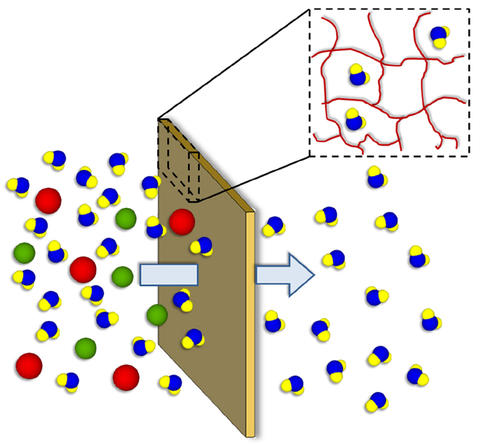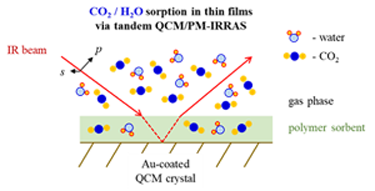Summary
Membranes and sorbents are key to the nation’s water and energy security. Polymer-based membranes already play a significant role in fields such as water purification, fuel cells and batteries, where they control the selective transport of ions and/or water. Polymer-based sorbents are increasingly being used to grab CO2 from the ambient air, through a reaction with amines groups within the polymer. These technologies leverage the the complex interplay between polymer structure and dynamics to control the transport and selectivity of small molecules into and through the material. To this end, we are developing and applying advanced measurement methods to quantify structure/property/transport in polymer-based membranes and sorbents to address the grand challenge of the energy-water nexus.

Description
We are developing and applying the following advanced tools to measure the structure, dynamics, and performance of polymer-based membranes and sorbents:
Vibrational Spectroscopy

We have developed a custom-built tandem quartz crystal microbalance (QCM), which measures total mass uptake of adsorbed species, and polarization modulation infrared absorption reflection spectroscopy (PM-IRRAS), a surface sensitive technique that provides vibrational spectra of thin polymer films on an IR reflective substrate. The nature of PM-IRRAS (rapidly switching between p and s polarization) enables us to conduct FTIR measurements in the presence of highly IR active gases (CO2, H2O, etc.), and only those molecules that absorb into the thin polymer film (solid phase) are visible. This combination of mass uptake (QCM) and chemical speciation (PM-IRRAS) is an extremely powerful tool for studying the in-situ swelling/sorption of candidate materials for direct air capture and membrane applications.
NMR Spectroscopy

Solid-state nuclear magnetic resonance (NMR) is a powerful method for determining detailed chemical structures in disordered solids, including a long history of determining structures in polymers. 13C cross polarization magic angle spinning (CPMAS) NMR is particularly useful for investigating complex mixtures of solids due to its quantitative and chemically selective nature, and its ability to determine spatial proximities of functional groups due to relaxation time averaging that occurs from local 1H spin exchange. We have demonstrated that 13C cross polarization magic angle spinning (CPMAS) is a powerful method for quantitatively monitoring the purity, cross-linking, and chemical composition in highly crosslinked polyamide-based membranes and is an essential tool in ascertaining atomistic models of polyamide structure. We are also using 1H pulsed field gradient (PFG) NMR to assess water mobility and diffusion in these types of membranes and then relating the water diffusion to the membrane composition and crosslink density.
Neutron Scattering

Neutron scattering can investigate both structure and dynamics of soft materials and membranes. When a neutron interacts with an atom within a sample, the scattering event can be elastic, inelastic or quasi-elastic. Elastically scattered neutrons yield useful information about the structure (i.e., spatial arrangement in space) of the membrane, whereas inelastic and quasi-elastically scattered neutrons yield information about the dynamics (i.e., how things move in space and time) within the membrane. By contrast matching, we can probe the structure and/or dynamics of the membrane, water, or both.

